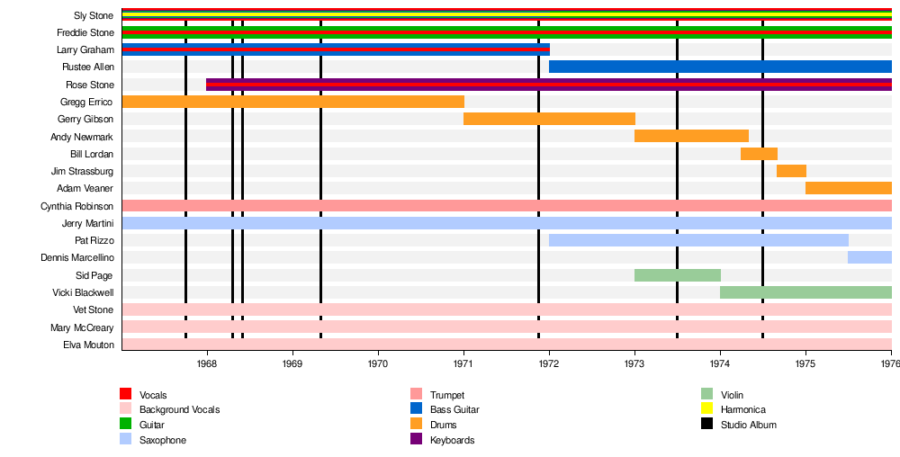Sly and the Family Stone in Five Celebrated Songs
Sly’s brand of ‘psychedelic funk’ was a perfect fit for the late sixties.
Prologue
It must have been Sylvester Stewart’s Bay Area upbringing: His band, Sly and the Family Stone, captured San Francisco’s hippie aesthetic of the late sixties: idealism, optimism, inclusion, and good vibes for all.
Musically, Sly and the Family Stone played an explosive mix of funk, psychedelic soul, and sunshine pop. Almost singlehandedly, the band started a revolution in soul music that had Sly competing with the more traditional brands of soul originating from Motown, Stax, and Muscle Shoals.
Sly walked the walk: The Family Stone was totally integrated, not only musically but racially and sexually. The two White guys were drummer Greg Errico and saxophonist Jerry Martini. The women were Sly’s sister Rose Stewart on keyboards and trumpeter Cynthia Robinson. Robinson’s cousin, Larry Graham, was recruited to play bass. It was a family affair.
Here is my playlist of Sly and the Family Stone in five celebrated songs:
1) “Dance to the Music” – 1968
Sly and the Family Stone’s second album Dance to the Music gave us the ubiquitous title song in 1968. But none of the Family Stone particularly liked the song when it was recorded in the fall of 1967.
“Dance to the Music” is really nothing more than Sly narrating how instruments impacted a Sly song. At the time, label chief Clive Davis was mightily impressed with the band’s unique flamboyant sound, called Sly “the hardest working musician I’d ever seen,” but nudged them toward a more commercial approach. Sly complied just this once. Sax player Jerry Martini reflected,
“It was so unhip to us. The beats were glorified Motown. We did the formula thing.”
The song launched Sly and the Family Stone into “pop consciousness” that came with heavy radio play.
2) “Everyday People” – 1968
“Everyday People,” from Stand!, was the band’s first single to place number one on Billboard‘s Hot 100, enjoying that position for four weeks in the winter of 1969. It’s one of the most covered songs in Sly’s repertoire, with versions by Aretha Franklin, Billy Paul, Joan Jett, the Staple Singers, Jeff Buckley, and various Motown artists.
The lyrical hook, “different Strokes for different folks,” basically summarizes the song’s meaning. Sly’s brother Freddy Stone in 2013 told Wax Poetics:
The things that were happening across the country changed us as people. We would begin having conversations…and Sly being the genius that he is, was putting these thoughts into songs.
Here is a one-minute, thirty-second clip of Sly and the Family Stone playing parts of “Everyday People” and “Dance to the Music,” on the Ed Sullivan Show on December 29, 1968, published by the Ed Sullivan Show via YouTube:
3) “Thank You (Falettime Be Mice Elf Again)” – 1969
Unlike the mid-tempo, mainstream pop feel of “Everyday People,” “Thank You” (for letting me be myself again) returned Sly to his funkiest. The song was released as a “double A-side” single along with “Everybody Is a Star.” The song reached number one on Billboard’s Hot 100 in February 1970.
The song is notable not only for Sly’s strange phonetic title. It also highlighted bass player Larry Graham, whose “thunkin’ and pluckin'” technique helped give his instrument a leading role in funk’s emergence.
Here is a performance clip from 1969, with takes of Larry Graham’s bass, published by Smurfstools Oldies Music Time Machine via YouTube:
4) “If You Want Me to Stay” – 1973
As the calendar flipped to 1970, prolific drug use diminished Sly Stewat’s songwriting capacity. The joyous, life-affirming optimism of Stand! turned dark and ominous with the 1971 release of There’s a Riot Goin’ On. Sly peeled off band members with impunity. It became sport for ticket buyers to guess whether Sly would show up to a particular concert (in 1970, 26 of 80 concerts were canceled).
Sly’s 1973 offering, Fresh, was produced without Larry Graham, who was busy founding a new band, Graham Central Station. Nevertheless, Fresh contained a sleeper hit, “If You Want Me to Stay,” lyrically passive but vocally flaunting Sly’s old magic.
Here is Sly performing “If You Want Me to Stay” alone on his keyboard, two and a half minutes, published by godlike51 via YouTube:
5) “Stand!” – 1969
Obviously, this playlist is not in chronological order. I’m saving the best ’til last. “Stand!” ranks high among my all-time favorite songs.
This is the title song from Sly’s fourth album, released in 1969. The album sold three million copies and is ranked number 118 on Rolling Stone magazine’s list of 500 greatest albums of all time. Stand! could be mistaken for a greatest hits album.
Credited as the sole songwriter, Sly Stone applied a gospel-like cadence to beckon listeners to stand up for themselves, their rights, and what they believed in.
Woodstock
Sly and the Family Stone’s Woodstock appearance is famous for the song, “I Want to Take You Higher.” But, significantly, they closed out the set with “Stand!” at 4:15 am on a Sunday morning. I could only find the audio version of the Woodstock performance, at three minutes and 20 seconds, published by Sly and the Family Stone via YouTube:
Coda
The band dissolved in the late seventies due to a combination of constantly missing gigs, Sly’s heavy drug use (he was busted for cocaine possession in 1983 in Ft. Meyers, Florida), and especially Rose Stone’s departure from the band.
Sly and the Family Stone was inducted into the Rock & Roll Hall of Fame in 1993. A tribute to the band took place at the Grammy Awards on February 8, 2006. Grammy producers were initially worried that Sly, who missed several rehearsals, would not show up to the event. They recruited several high-profile musicians (John Legend, Nile Rodgers, Steven Tyler, and the Black Eyed Peas) to perform Sly and the Family Stone songs.
Sly Stone appeared in the middle of the broadcast.



















































































































